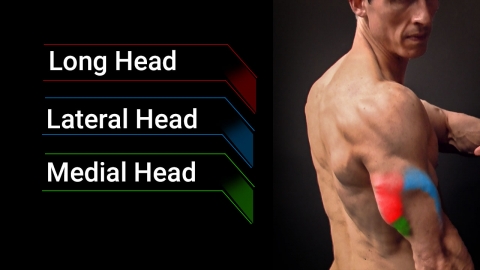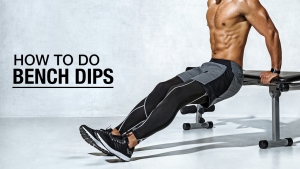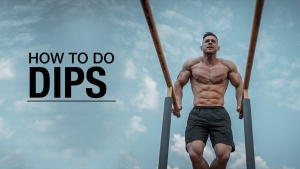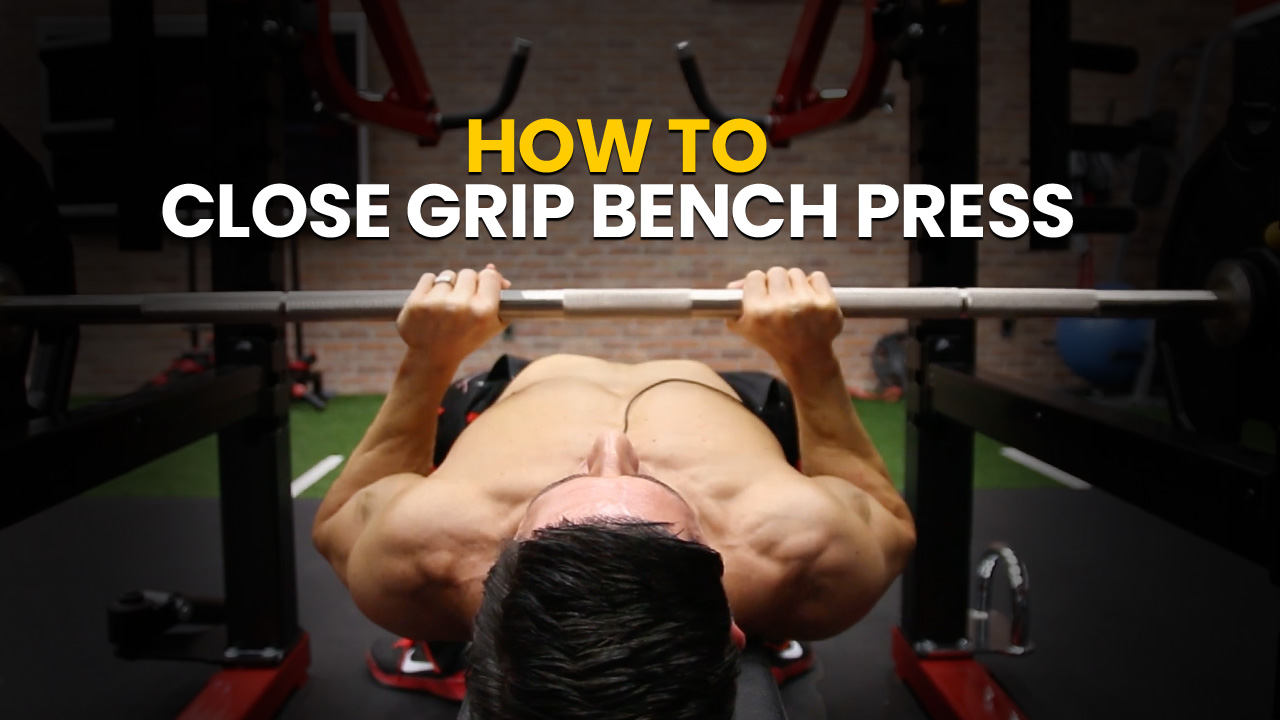
BENEFITS OF THE CLOSE GRIP BENCH PRESS
The Close Grip Bench Press is more than just another bench variation.
It’s a tool designed to target those lagging triceps.
Unlike the traditional or wider grip Bench Press that emphasizes your upper chest, the close-grip version shifts the spotlight to your triceps, turning it into a tricep powerhouse movement.
It also calls upon your pectoral muscles and anterior deltoids to join the party as secondary muscles, making it a comprehensive upper-body resistance exercise.
In this guide, we’ll break down the muscles worked, dive into the correct form, highlight common mistakes to avoid, explain mechanical variables, and compare the dumbbell versus barbell variations.
Whether you’re a beginner aiming to add variety to your workout or an advanced lifter looking to fine-tune your technique, this article is your ticket to elevating your Bench Press performance.
Let’s get ready to push your limits and unlock the full potential of the Close Grip Bench Press.
CLOSE GRIP BENCH PRESS: MUSCLES WORKED
I’d like to begin by highlighting the muscle groups engaged during the Close Grip Bench Press.
Why is it important to understand these muscles?
The concept of mind-to-muscle connection plays a pivotal role here.
Developing a strong mind-to-muscle balance can drastically improve the efficiency of your workouts.
By intentionally activating and concentrating on the muscles involved, you’re able to avoid improper technique, minimize the likelihood of injuries, and optimize muscle building potential.
This method goes beyond just doing a chest exercise; it’s about really paying attention to and working the muscles you want to improve. This helps you grow stronger and more fit.
Let’s explore the primary muscles the Close Grip Bench Press targets, notably the triceps brachii, pectoralis major (chest muscles), and anterior deltoids (front shoulders).
TRICEPS BRACHII
When you’re performing the Close Grip Bench Press, a key muscle group you’re focusing on is the triceps brachii, which are the muscles on the back of your upper arm.
Imagine your triceps as a trio of muscles starting from two separate places: one part begins at the back of your shoulder blade, and the other two parts start on your upper arm bone.
These three parts come together in a single tendon that attaches to the back of your elbow.
Why are the triceps so important when you’re doing the Close Grip Bench Press?
Here’s what the triceps help you accomplish:
- Elbow Extension: This is the main action of finishing the press, straightening your arm to push the weight up. But it’s also a fundamental movement for many daily tasks, like reaching for something on a high shelf or throwing a ball.
- Stabilize Your Elbow and Shoulder Joints: Strong triceps provide support for your elbow and shoulder, especially when lifting heavy weights. This stabilization is essential for maintaining good form and preventing injuries during the exercise.
- Lockout the Movement: At the top of the Flat Barbell Bench Press, the triceps are crucial for locking out your arms and completing the lift. This final push ensures you’re fully engaging and strengthening these muscles.
Focusing on the triceps during the Close Grip Bench Press, by consciously contracting and extending them, enhances your ability to perform the exercise effectively. This not only leads to stronger triceps but also contributes to your overall upper body strength and functionality.
PECTORALIS MAJOR
Now, let’s shift our focus to the pectoralis major, your primary chest muscles.
Think of this muscle as having two main parts: one that attaches to your collarbone and another that starts from your sternum and your ribs.
These segments stretch across your chest and attach to your upper arm bone, just near your shoulder.
So, why does this matter when you’re doing the Close Grip Bench Press?
Here’s what the pectoralis major helps you do:
- Push the Weight Up: Essential for lifting the barbell off your chest. This movement is central not just to bench pressing, but to any pushing action you do in your daily life, like pushing a door open or shoving a heavy object away from you.
- Bring Your Arms Together: Whenever you’re squeezing your arms together in front of your body, your pectoralis major is at work. This is crucial for exercises that require your arms to come towards the centerline of your body, enhancing the muscle’s strength and definition.
- Stabilize Your Shoulder: The pectoralis major plays a significant role in holding your shoulder joint in place. This stability is key for preventing injuries and ensuring you can lift safely and effectively.
Understanding these muscle functions can help you visualize and focus on engaging your chest muscles during the Close Grip Bench Press, leading to more effective workouts and better muscle development.
ANTERIOR DELTOIDS
Lastly, we turn our attention to the anterior deltoids, or the front shoulders.
Picture the anterior deltoids as the shield of your upper arm, located right at the front of your shoulder.
They start from the collarbone and stretch down to attach to the upper part of your arm bone. This positioning allows them to play a crucial role in several upper body movements.
Why do the anterior deltoids matter when you’re doing the Close Grip Bench Press?
Here’s what the anterior delts do:
- Initiate the Press: As you begin to push the barbell upwards, your anterior deltoids kick into action. They’re involved in the initial lift-off from your chest, working in tandem with your chest and triceps.
- Raise Your Arm: When you lift your arm in front of you, whether during a Barbell Bench Press or simply reaching out to grab something, your anterior deltoids are at work. This is especially true for movements that involve lifting your arms up and forward.
- Support Upper Body Stability: Beyond just lifting, the anterior deltoids help stabilize your shoulders during the press. This ensures that you can perform the exercise safely and effectively, minimizing the risk of injury.
By focusing on engaging your anterior deltoids during the flat Barbell Close-Grip Bench Press, you can enhance their development along with improving your overall shoulder health and functionality.
This targeted engagement also contributes to a more balanced and powerful upper body, capable of handling both everyday activities and rigorous workout routines.
HOW TO DO THE CLOSE GRIP BENCH PRESS
The Close Grip Bench Press stands out as a variation of the traditional Bench Press that focuses on enhancing tricep strength and size, offering versatility that the Triceps Pushdown lacks.
While Triceps Pushdowns require a cable machine and might be somewhat replicated with resistance bands at home, they’re not the ideal solution to see serious results in your triceps.
On the other hand, the Close Grip Bench Press can be executed using either barbells or dumbbells, offering flexibility in where and how you can perform this exercise.
Here’s how to do both types of the Close-Grip Bench Press form using a barbell or a pair of dumbbells.
DUMBBELL CLOSE GRIP BENCH PRESS

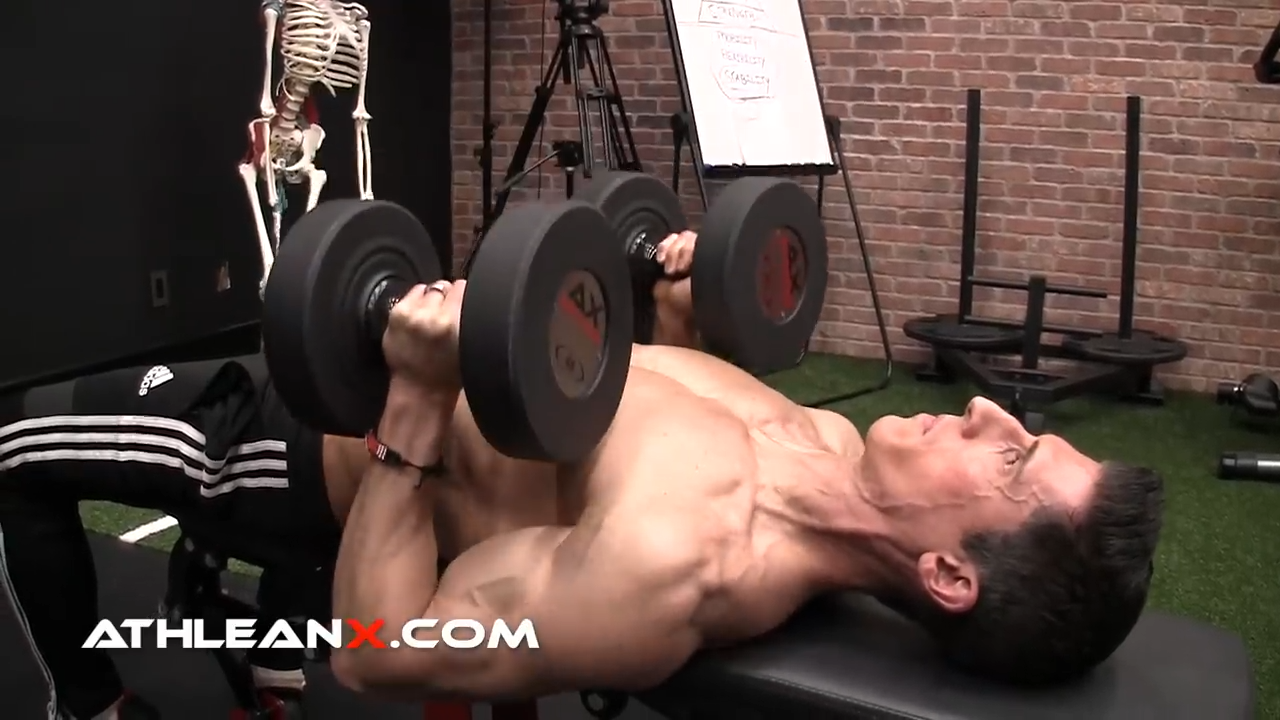
HOW TO DO THE DUMBBELL CLOSE GRIP BENCH PRESS:
- Locate a flat bench station and lie down on it with your back flat against the surface. If a bench is not available, you can also perform this exercise lying flat on the floor.
- Place your feet flat on the ground, spaced shoulder-width apart for stability.
- Hold a dumbbell in each hand. Your palms should be facing each other, positioned over the middle of your chest. Start with your elbows bent and the dumbbells at chest level, ensuring your hands are close together but not touching.
- Tighten your core, press your feet firmly into the ground, and take a deep breath. This will help stabilize your body during the lift.
- Breathe out while pushing the dumbbells straight up over your chest, straightening your arms. Ensure the dumbbells remain close to each other during the upward push. Extend your arms completely, but make sure not to lock your elbows when you reach the peak of the motion.
- Once your arms are fully extended, hold the position for a brief moment. This pause ensures that you’re fully engaging your triceps and chest muscles.
- Inhale as you slowly lower the dumbbells back to the starting position. Keep the movement controlled to ensure your muscles are under tension throughout.
WHAT MAKES IT EFFECTIVE: The Dumbbell Close Grip Bench Press offers better muscle activation and range of motion than the barbell version, allowing for individual arm movement that can lead to more balanced strength development and reduced injury risk.
BARBELL CLOSE GRIP BENCH PRESS

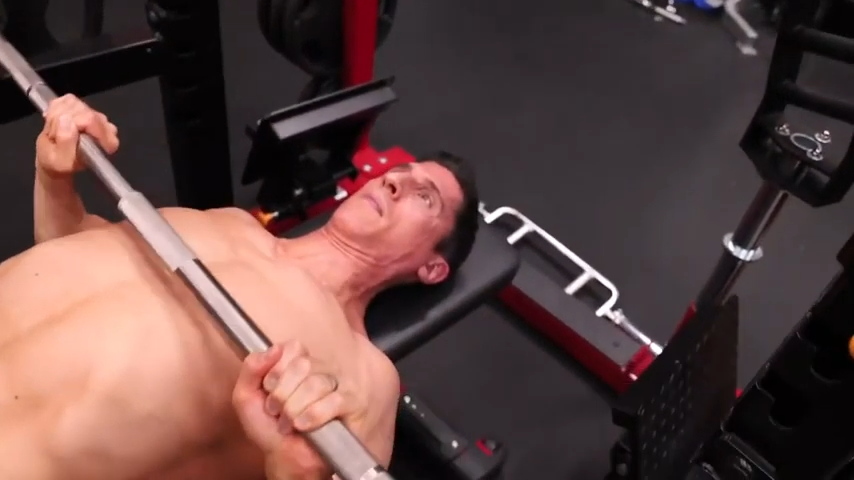
HOW TO DO THE BARBELL CLOSE GRIP BENCH PRESS:
- Lie down on a flat bench, positioning your body so that your eyes are aligned right beneath the barbell.
- Hold the barbell using an overhand grip, positioning your hands at or just inside shoulder width; this narrower grip is essential for focusing on the triceps.
- With the help of a spotter or using your own strength, lift the barbell from the rack and hold it straight over your chest with your arms fully extended. This is your starting position.
- Slowly lower the bar towards the middle of your chest by bending your elbows. Keep your elbows close to your body to emphasize tricep involvement. Inhale as you perform this part of the movement.
- Breathe out while pushing the barbell up to the initial position, fully straightening your arms without locking your elbows, and concentrate on engaging your triceps to power the lift.
- Throughout the exercise, keep your feet flat on the floor, your back slightly arched, and your shoulder blades retracted. This stable base will help you lift more efficiently and safely.
- Complete the desired number of repetitions, ensuring each rep is performed with controlled motion to maximize muscle engagement.
- After completing your set, carefully return the barbell to the rack. If you’re lifting heavy weights, it’s wise to have a spotter assist you with this step to avoid injury.
WHAT MAKES IT EFFECTIVE: The barbell version of the Close Grip Bench Press allows for heavier weights to be lifted, promoting greater strength gains and muscle mass development in the triceps and chest compared to the dumbbell version.
INCORPORATING BENCH PRESS VARIATIONS
Going from traditional Bench Presses to the hyper-focused option of the Close-Grip Bench Press marks a transition towards targeting specific muscle groups more intensively.
While both the standard and narrow-grip bench presses are staples in enhancing upper body strength, incorporating incline and decline variations can also help with comprehensive muscular development.
The Incline Bench Press, for instance, accentuates the upper chest and shoulders, complementing the tricep-focused close-grip press.
This strategy ensures a balanced progression towards achieving larger muscles and more pronounced muscle definition.
NAVIGATING RISKS & TAILORING TO GOALS
But before you upgrade your routine to include Bench Press variations, it’s important to understand the inherent risks, especially for individuals with shoulder or elbow issues.
For example, the shoulder abduction required in Wide-Grip Bench Presses can exacerbate cranky shoulder joints, whereas the close or normal grip variations tend to be more forgiving.
Similarly, athletes and lifters with elbow pain might find the narrower grip less aggravating, highlighting the importance of aligning bench variations with personal health considerations and fitness goals.
BODYWEIGHT EXERCISE & DYNAMIC MOVEMENTS
To further improve upper body strength and agility, integrating bodyweight exercises such as the Diamond Push-Up can prove useful.
This variation, known for its intense focus on the triceps and the chest, mimics the Close-Grip Press’s benefits without needing equipment.
Moreover, exercises like the Chest Press in a gym routine underscore the functional application of bench-induced strength, helping improve athletic ability, going beyond the confines of a flat bench with a rack.
TECHNICAL PRECISION
The transition from a Flat Barbell Bench Press to more intricate movements like the Incline Barbell Bench Press or the narrow-grip version demands careful attention to technique.
A breakdown in form can lead to muscle imbalances and potential injury over time.
Therefore, emphasizing the lockout position, maintaining an extended range of motion without venturing into a limited range, and making seemingly insignificant technique tweaks can enhance the exercise’s effectiveness and safety.
COMMON CLOSE-GRIP BENCH PRESS MISTAKES
The Close Grip Bench Press is a great variation of the conventional Bench Press, homing in on triceps strength with a precision that its wide-grip counterpart might not offer.
However, as with any exercise, especially one as effective as this for targeting the primary muscle groups like the triceps, chest muscles, and to some extent, the shoulder muscles, the risk of injury can increase without proper form.
Here are the most common Bench Press mistakes seen in this bench variation and how to avoid them to ensure your bench press performance is both effective and safe.
INCORRECT HAND POSITION
One of the foundational aspects of the Close-Grip Bench Press is, unsurprisingly, the grip.
The narrower grip is essential for shifting the focus more towards the triceps muscles.
However, a grip that’s too close can put unnecessary stress on your wrist joints and potentially lead to muscle imbalances.
Ideally, your hands should be shoulder-width or just inside shoulder-width apart, allowing for optimal muscle engagement without overloading the joints.
ELBOW FLARE
Elbow flaring is a common mistake in many bench press variations, and the Close-Grip Bench Press is no exception.
Allowing your elbows to flare out wide shifts the emphasis away from the triceps and can lead to shoulder discomfort.
Instead, your elbows should stay closer to your body, enhancing triceps activation and reducing the strain on your shoulder joints.
NEGLECTING SHOULDER BLADE RETRACTION
Failing to retract your shoulder blades is a common oversight that can lead to a compromised starting position.
This retraction is crucial for stabilizing your shoulder joints and providing a solid foundation from which to press.
By retracting and squeezing your shoulder blades together on the flat bench, you not only protect your shoulders but also create a more stable base to lift heavier weights safely.
OVERLOOKING THE IMPORTANCE OF A FULL RANGE OF MOTION
Skimping on the depth of your press limits the range of motion and, consequently, the effectiveness of the exercise.
A full extension is key to maximizing triceps strength and ensuring you’re engaging the muscles through their complete range.
Cutting your movement short not only hampers muscle development but can also foster bad habits that are hard to break.
EXCESSIVE WEIGHT
While it’s tempting to load the barbell with heavy weights to accelerate muscle growth, starting with heavy bench pressing can lead to a breakdown in technique and increase the risk of injury.
It’s vital to begin with a manageable weight that allows you to maintain controlled movements throughout the entire exercise.
Over time, as your technique improves and your triceps grow stronger, gradually increase the weight to continue challenging your muscles.
IGNORING BODY POSITION AND MOVEMENT QUALITY
The entire movement pattern of the Close-Grip Bench Press, from the controlled descent to the powerful push-up, should be smooth and deliberate.
Paying close attention to your body position, especially maintaining a slight natural arch in your back, and keeping your feet planted firmly on the ground, can significantly improve the effectiveness of the exercise, and minimize the degree of risk.
Incorporating the Close Grip Bench Press into your workout routine, when done with proper form and being mindful of these common mistakes, can significantly enhance your triceps muscle strength, muscle size, and overall upper body aesthetics.
Whether you choose the Barbell Close-Grip Bench Press, the Close-Grip Dumbbell Bench Press, or even variations like the Incline Close-Grip Bench Press, understanding and applying the right technique is paramount.
Remember, the goal among athletes and fitness enthusiasts should always be maximum muscle development while minimizing injury risk.
If you’re looking for a training program to get you strong and ripped from head to toe, be sure to try our Program Selector and grab the ATHLEAN-X program that best matches your current training goals. We’ve got something for everyone… from beginners to experienced lifters.

- Here’s how to perform the Barbell Close Grip Bench Press:
- Position yourself on a flat bench, making sure your eyes are directly under the barbell.
- Grab the barbell with an overhand grip, keeping your hands shoulder-width apart or a bit closer to target the triceps more effectively.
- Use a spotter’s assistance or your strength to unrack the barbell, holding it above your chest with arms extended – this marks your starting point.
- Gently bend your elbows to lower the bar to your chest’s center, keeping elbows tight to your sides to focus on the triceps, inhale during this movement.
- As you exhale, press the barbell back to the starting spot, straightening your arms without locking the elbows, and use your triceps’ force for the motion.
- Maintain your feet flat, back slightly arched, and shoulder blades squeezed together for a solid and efficient lifting foundation.
- Aim for the number of reps you’ve set, focusing on controlled movements to engage the major muscles fully.
- You can also use a pair of dumbbells to perform the Close-Grip Bench Press. Dumbbells require individual arm control, allowing for natural wrist movement and engaging stabilizing muscles for improved form and symmetry.
CLOSE GRIP BENCH PRESS FAQS
The Close Grip Bench Press primarily targets the triceps brachii, emphasizing the development of strength and muscle mass in the back of the upper arms.
Additionally, this exercise engages the pectoralis major (chest muscles) and the anterior deltoids (front shoulders), making it a comprehensive upper-body workout that enhances pushing strength, arm definition, and overall muscular balance.
For the Close Grip Bench Press, position your hands in a closer grip on the barbell than you would for a standard grip Bench Press.
Aim to place them about shoulder-width apart or slightly less.
This closer hand positioning is key to making sure the focus is on strengthening and building your triceps, while still engaging your chest and shoulders.
The main difference between these two lies in the grip width on the barbell.
In a Standard Bench Press, your hands are spaced wider apart, usually a bit beyond shoulder width, focusing the workout more on your chest muscles (pectoralis major) and less on your triceps.
On the other hand, the Close Grip Bench Press requires your hands to be placed closer together, about shoulder width or narrower.
This adjustment shifts the emphasis significantly towards your triceps, making it an effective weightlifting exercise for arm strength and definition, while still engaging your chest and shoulders, but to a lesser extent compared to the standard variation.
REFERENCES

Jeff Cavaliere M.S.P.T, CSCS
Jeff Cavaliere is a Physical Therapist, Strength Coach and creator of the ATHLEAN-X Training Programs and ATHLEAN-Rx Supplements. He has a Masters in Physical Therapy (MSPT) and has worked as Head Physical Therapist for the New York Mets, as well as training many elite professional athletes in Major League Baseball, NFL, MMA and professional wrestling. His programs produce “next level” achievements in muscle size, strength and performance for professional athletes and anyone looking to build a muscular athletic physique.
















